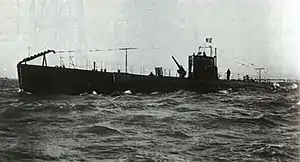Argonauta-class submarine
The Argonauta-class submarine was the first sub-class of the 600 Series of coastal submarines built for the Regia Marina (Royal Italian Navy) during the 1930s. Some of these boats played a minor role in the Spanish Civil War of 1936–1939 supporting the Spanish Nationalists. Of the seven boats built in this class, only a single one survived the Second World War.
 Argonauta | |
| Class overview | |
|---|---|
| Name: | Argonauta class |
| Builders: | |
| Operators: |
|
| Preceded by: | Argo class |
| Succeeded by: | Sirena class |
| Built: | 1929–1933 |
| In commission: | 1932–1948 |
| Completed: | 7 |
| Lost: | 6 |
| Scrapped: | 1 |
| General characteristics | |
| Type: | Submarine |
| Displacement: | |
| Length: | 61.5 m (202 ft) |
| Beam: | 5.7 m (18 ft 8 in) |
| Draft: | 4.7 m (15 ft 5 in) |
| Installed power: | |
| Propulsion: |
|
| Speed: |
|
| Range: |
|
| Test depth: | 80 m (260 ft) |
| Armament: |
|
Design and description
The Argonauta class was derived from the earlier Squalo-class submarines.[1] They displaced 660 metric tons (650 long tons) surfaced and 813 metric tons (800 long tons) submerged. The submarines were 61.5 meters (201 ft 9 in) long, had a beam of 5.7 meters (18 ft 8 in) and a draft of 4.7 meters (15 ft 5 in).[2] They had an operational diving depth of 80 meters (260 ft).[1] Their crew numbered 44 officers and enlisted men.[2]
For surface running, the boats were powered by two 750-brake-horsepower (559 kW) diesel engines, each driving one propeller shaft. When submerged each propeller was driven by a 400-horsepower (298 kW) electric motor. They could reach 14 knots (26 km/h; 16 mph) on the surface and 8 knots (15 km/h; 9.2 mph) underwater.[1] On the surface, the Settembrini class had a range of 5,000 nautical miles (9,300 km; 5,800 mi) at 8 knots (15 km/h; 9.2 mph);[2] submerged, they had a range of 110 nmi (200 km; 130 mi) at 3 knots (5.6 km/h; 3.5 mph).[1]
The boats were armed with six 53.3-centimeter (21 in) torpedo tubes, four in the bow and two in the stern for which they carried a total of 12 torpedoes. They were also armed with a single 102-millimeter (4 in) deck gun forward of the conning tower for combat on the surface. Their anti-aircraft armament consisted of two single 13.2-millimeter (0.52 in) machine guns.[2]
Ships
| Ship | Builder[2] | Launched[2] | Fate[2] |
|---|---|---|---|
| Argonauta | Cantieri Riuniti dell'Adriatico, Monfalcone | 19 January 1931 | Sunk by British aircraft, 28 June 1940 |
| Fisalia | 2 May 1931 | Sunk by HMS Hyacinth, 28 September 1941 | |
| Jalea | Odero Terni Orlando, Muggiano | 15 June 1932 | Discarded, 1 February 1948 |
| Jantina | 16 May 1932 | Sunk by HMS Torbay, 5 July 1941 | |
| Medusa | Cantieri Riuniti dell'Adriatico, Monfalcone | 10 December 1931 | Sunk by HMS Thorn, 30 January 1942 |
| Salpa | Cantieri navali Tosi di Taranto, Taranto | 8 May 1932 | Sunk by HMS Triumph, 27 June 1941 |
| Serpente | 28 February 1932 | Scuttled at Ancona, 12 September 1943 | |
Service
The seven Argonauta-class submarines saw action during the Second World War. Five were sunk in action during the conflict and a sixth was scuttled at the Italian armistice in 1943. The last surviving boat of the class was stricken in 1948.
Notes
- Bagnasco, p. 146
- Chesneau, p. 309
References
- Bagnasco, Erminio (1977). Submarines of World War Two. Annapolis, Maryland: Naval Institute Press. ISBN 0-87021-962-6.
- Brescia, Maurizio (2012). Mussolini's Navy: A Reference Guide to the Regina Marina 1930–45. Annapolis, Maryland: Naval Institute Press. ISBN 978-1-59114-544-8.
- Chesneau, Roger, ed. (1980). Conway's All the World's Fighting Ships 1922–1946. Greenwich, UK: Conway Maritime Press. ISBN 0-85177-146-7.
- Frank, Willard C., Jr. (1989). "Question 12/88". Warship International. XXVI (1): 95–97. ISSN 0043-0374.
- Rohwer, Jürgen (2005). Chronology of the War at Sea 1939–1945: The Naval History of World War Two (Third Revised ed.). Annapolis, Maryland: Naval Institute Press. ISBN 1-59114-119-2.